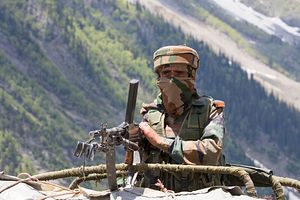July was a busy month for India-Pakistan relations. Indian Prime Minister Narendra Modi met with his Pakistani counterpart Nawaz Sharif on the sidelines of the Shanghai Cooperation Organization Summit in Ufa, Russia, with the two agreeing that their respective national security advisors would meet to discuss ways to combat terrorism.
But just a week or so after this diplomacy, the two countries once again exchanged gunfire across their disputed frontier in Kashmir. According to reports, a heavy exchange between the Indian and Pakistani troopers took place along the line of control (LoC) in Jammu’s Poonch district. As usual, each side blamed the other for the incident. An unnamed Indian defense spokesman was reported as accusing Pakistani troops of opening fire on several posts along the Line of Control that divides Kashmir. He was quoted as saying that Indian forces responded with their own barrage to the “unprovoked firing” by Pakistani forces. In contrast, Pakistani officials had earlier said in a statement that Indian troops used heavy weapons on July 18, when Muslims were celebrating the Eid-ul-Fitr (marking the end of the holy month of Ramazan), to pound Nezapir in Kashmir.
Over the past week more clashes were reported, including one in which an Indian soldier was reportedly killed by a Pakistani sniper. It was in fact the third sniper attack this month, and the 18th ceasefire violation in a month that has four people killed and 14 wounded. The exchanges have continued into this weekend.
Meanwhile, a single attack in Gurdaspur, Punjab on Monday left seven dead. India has blamed Pakistani terrorists for the attack, an accusation Pakistan has vehemently denied.
The incidents have raised concerns that the planned meeting of the national security advisors would be derailed, although for now, the talks – tentatively scheduled for late August – look to be going ahead.
A History of Trouble
Hari Singh, the last ruling Maharaja of Jammu and Kashmir, wanted to be independent but under pressure from both India and Pakistan, in 1947 elected to accede to India. That led to the first war between India and Pakistan in 1947-48. Since then, the Kashmir region has been a flashpoint between the two countries.
Since it was created in 1949, the United Nations Military Observer Group in Indian and Pakistan (UNMOGIP) has been supervising the ceasefire in the disputed Jammu and Kashmir region. Pakistani army officials say they have informed the UNMOGIP about alleged recent ceasefire violations by India and asked the monitors to investigate the incidents. Subsequently, a team visited Sialkot Working Boundary, and inspected the areas targeted by recent firing by the India Border Security Force. According to Pakistan’s Inter-Services Public Relations, the UNMOGIP officers visited the Sullehpor, Chaprar, and Milanay sectors of the Line of Control. Pakistan also summoned the Indian ambassador after a “spy drone” was downed in disputed Kashmir.
Meanwhile, New Delhi has lodged its own complaint with the UNMOGIP, when one of its civilians was killed during gunfire on the border.
The U.S., China and Russia have for years been trying to push India and Pakistan to repair relations. The antipathy between the two countries is a factor in regional conflicts, notably in Afghanistan.
In 2003, India and Pakistan did agree to a ceasefire along the Line of Control in Kashmir, and subsequently began peace talks. That process was suspended in the wake of the 2008 Mumbai terrorist attacks, which New Delhi blamed on Pakistan-based militants.
Amit Ranjan, a Delhi-based scholar, pointed out to The Diplomat that incidents regularly occur just as India and Pakistan are about to enter negotiations. According to Ranja, the blame can be laid at the feet of institutions that do not approve of talks, and which seek to derail the process. Take, for instance, the bonhomie created between the Indian and Pakistani prime ministers at Lahore in 1999, which quickly gave way to the Kargil War. Then, in 2007-08, when the two countries were looking for a breakthrough on the Kashmir issue, the devastating attacks on Mumbai occurred. There are more examples, all suggesting that those who have profited from conflict are reluctant to give peace a chance.
Now, Ranja notes, “Despite the meeting of the two prime ministers at Ufa, gunfire [has been exchanged] on the India-Pakistan international border, even on the eve of Eid, when the two sides used to exchange sweets. Who started firing is like a chicken and egg puzzle which one cannot resolve; both sides accuse the other.”
Ranja concludes that unless these institutions agree to permit a breakthrough, their machinations will always defeat the goodwill gestures of the political leaderships of India and Pakistan, scuttling any chance of peace between the two countries.
The author is a columnist at the Daily Times. Visit his blog or follow him on Twitter @Akbar_notezai. He can be reached at [email protected].

































